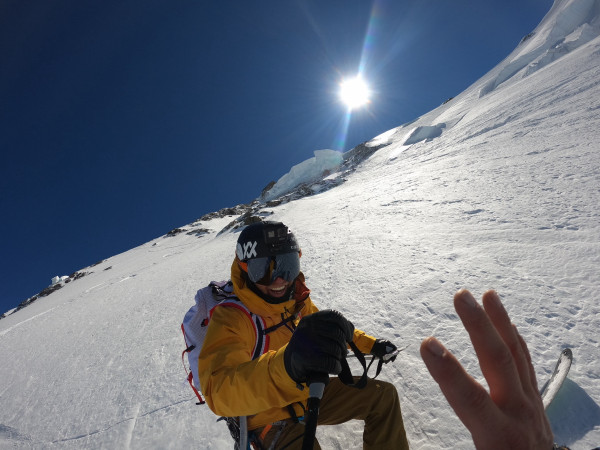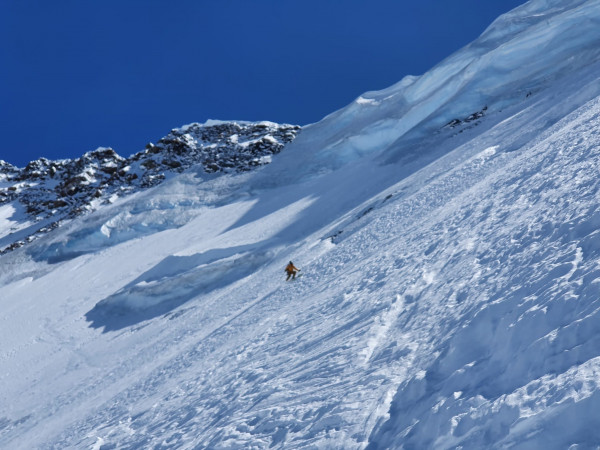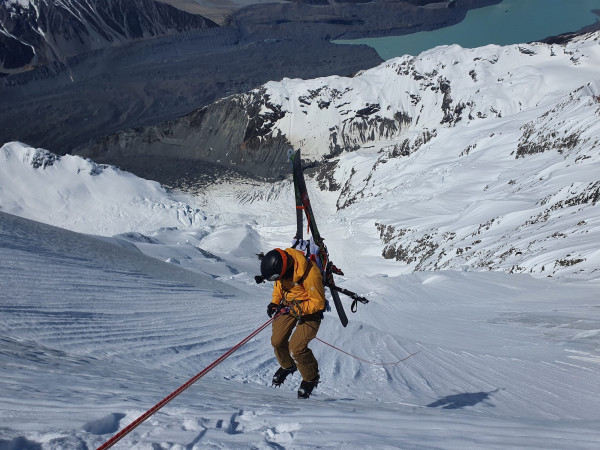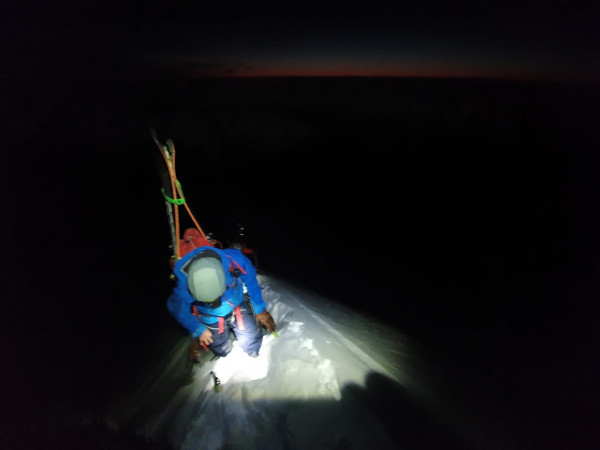It’s not a waste of a trip if you survive right? | Will's story
To climb Aoraki/Mt Cook’s East Ridge to then ski 2000m down New Zealand’s largest skiable slope is not for the faint hearted. Rather, it’s for three of the country’s most skilled and confident alpine and ski mountaineers.
In October last year, Will Rowntree and fellow ski mountaineers; professional skier Sam Smoothy and Dr Joe Collinson became the only Kiwi team to successfully tackle the Caroline Face on New Zealand’s highest peak.
Mitigating the maze of physical hazards including slab and serac avalanches, to the heuristic trap of ‘commitment creep’ in such a charged, high-risk quest were at the forefront of Will’s mind during the 16-hour trip.

Will, Snow Safety Officer at The Remarkables, has channelled his career into snow safety, avalanche forecasting, and avalanche control which has seen him working 14 years in the industry. It’s taken him across the world where he spent four years collectively ski guiding in Japan, ski-patrolling in United States and Canada, and the rest in New Zealand ski fields with NZ Ski.
“I've been doing the whole mountain thing for a while now - ski mountaineering and backcountry skiing are probably my main passions in life.”
Will is not new to the Aoraki/Mt Cook terrain having skied the East Face and the Nor-West Couloir.
The mission required the trio to climb from Plateau Hut up the East Ridge of Aoraki/Mt Cook to just below Middle Peak (3717m). Based on research and using images taken in the helicopter fly-by the afternoon before, they were able to plot their planned route.

“That was critical to be honest - having day-old photos on our phones to reference while we were on the face, translating where we were to a picture, was key,” Will said.
After leaving Plateau Hut, the first stint to the flat spot on the East Ridge meant they would get a better indication of the ski conditions on the face, making that their first out of eight important decision-making points.
“On any trip, you need to decide on the parameters of what you want to find there. For us we wanted to find cold snow that’s good to ski and make turns on safely, and to get an idea on slab avalanche hazards on the face itself.”
Before climbing the firm blue ice towards Porter Col, Will said it was about seeing how the team was feeling, “was there any fatigue? Because you start to get very committed to the mountain at that point”.
“At any given point it’s never too late to turn around, but when you start into that climbing and pitching mode it becomes harder to turn around,” he says.
About 45 minutes after sunrise, the trio had great vision of the conditions.
“Then this huge powder cloud [avalanche] rumbled down the valley, and there was a split in the group about how we all thought about it.”
“It then quickly went from ‘this is going to be really f**king awesome, and we have great conditions’, to ‘oh sh*t this is full on and are we even going to do this?’”
It was clear that no decisions could be made until they got off the ridge and could assess the situation.
“After seeing the powder cloud, the decision-making was not only snow-focused but now working through the differing opinions on where the avalanche had come from.
“Although there was a period of disagreement, it was a positive constructive discussion, but it was decided that we needed the snow-based evidence - whether that was a slab avalanche or a serac fall.”
Being in such volatile terrain meant the group held robust discussions like this throughout the rest of the trip; weighing up other route options and pre-discussed back up plans.
“The night before in the hut we really hammered home that anyone had the freedom to veto at any point. We had a really good team dynamic, so we would obviously talk about why and how even if we didn’t agree on something. It was talked about in a constructive way."
Reaching Porter Col confirmed that the avalanche they witnessed was a serac fall and not on their proposed route, giving them the confidence to abseil 80m over the ice cliffs from Middle Peak to the face.

“I got down there first, and I was trying to manage my emotions because I could see it was going to be great.”
“I did some quick ‘hand shears’ where I basically dig down into the snow with my ski pole, isolate a block, and then put my hand under and push. This technique gives me a quick idea of the stability of the snowpack, and if there was a layer within the snow that has the potential to fail if we put more weight into it.
“My hand just ripped through, which was a really really good thing - it would be bad if the block stayed in one piece and slid off.
“It was probably the best conditions I could have asked for."
From there they started skiing, and it became an exercise in route finding. Will says the crazy thing about the Caroline Face is its sheer size, with the 2.5hours of skiing across the 2000m.
With the overhead avalanche hazard, the three chose the more uncommon style of skiing at the same time, about 200m apart.
“We were skiing above these huge cliffs, and if there was any avalanche you would just fall off into the abyss. You are really running a numbers game spending time on the face.
“From a decision point of view, it’s about what is the greatest hazard, and spending too much time on the face was the biggest one.
“At the same time we were concerned about avalanching each other which was why we had the spacing, but to move faster we went together to minimise time on the face.”
They skied about 1000m before abseiling over another massive ice cliff.
“We were 1500m lower than where we started, and so we are now starting to see a loose wet avalanche problem.”
“Recognising the different types of hazards was really critical. We had to change the way we moved through the terrain compared to when we were up higher.
“If you got caught in a small one, the consequence of the terrain we were in was really significant. We were dealing with a low size, high consequence terrain."
Nearing the end of the intense navigating, the group found the ramp to take them back across the glacier to the hut.
“There was a lot of hugs and whoop whoops,” Will laughed.
The trip had been an ambitious idea of his for many years after meeting a group of Europeans at Plateau Hut the night before they successfully completed the first descent of the same route in 2017.
“People keep saying ‘oh you must’ve been planning that for years’, but in fact it was only about four days beforehand.
“The thing is, you can only pick the right objective with the weather window you have,” Will says.
While the idea had been on the list, he had been waiting years for the right conditions.
Reflecting on the record trip, Will admitted the “main stressful part was trying to sleep the night before from a nerves point of view”.

“You don’t want it to be stressful, we were choosing to go and do it. It’s fun, that’s why we wanted to go for it.
“It was more of charged energy. It’s high risk so you were very much in a flow state - nothing else is going on apart from what's going on in front of you and the objective.”
“Once you make the decision to commit, that’s when it becomes most enjoyable. You get to the point where you’re like ‘yes we are doing this now’.”
The reality of ‘commitment creep’
Will says ‘commitment creep’ catches people out “all the time”.
“No matter your experience, whether you’ve been doing it for one year or 20 years, everyone battles with it, he says.
“When you’re talking about objective-based skiing, you put a lot of time and money, mental commitment into going for this one mountain or one line.
“When you're at the top of it, one of two things will happen – if you get up there and it’s just not safe to ski, what your brain will start doing is warp the evidence., you start ignoring the evidence there for not skiing it and highlighting the stuff that would support it.
“Sometimes people just go ‘stuff it we are here’, while knowing there’s risk. It’s unbelievable how much the human brain will ignore it because it just does not want to do the hard yards and return."
The human brain is your biggest asset but also your biggest enemy.
“Knowing these types of traps helps you identify if you as an individual or group are falling down one of those holes,” he states.
“At that middle peak we said, ‘let’s check we aren’t falling into the commitment creep group’.”
Before any trip, have a clearly identified Plan B and C, he advises.
“If you have those established, it’s so much easier to turn around as you’ve already accepted that that is an option."
“It’s not a waste of a trip if you survive, right? That’s what it comes down to.”
Thanks for sharing your story with us Will, every experience in the mountains provides opportunities to learn and sharing these can help others learn too. If others have a story to share, they are welcome to get in touch with us at the NZ Mountain Safety Council.
Stay safe this winter
- Read our other story from another adventurer
- Find the forecast for your destination
- Kickstart your avalanche awareness
PHOTOS:
Photo 1: Sam Smoothy and Joe Collinson climbing down steep ice into Porter Col. PHOTO/WILL ROWNTREE
Photo 2: Sam Smoothy. PHOTO/SUPPLIED
Photo 3: Sam Smoothy skiing the upper section of the Caroline Face. PHOTO/JOE COLLINSON
Photo 4: Sam Smoothy completing one of a few abseils throughout the mission. PHOTO/WILL ROWNTREE
Photo 5: Will Rowntree on East Ridge with first light on the horizon. PHOTO/SAM SMOOTHY